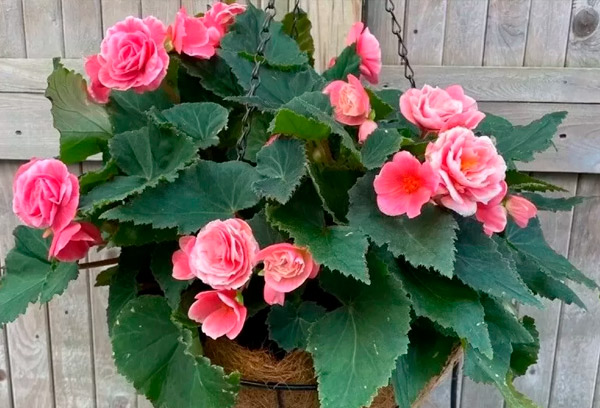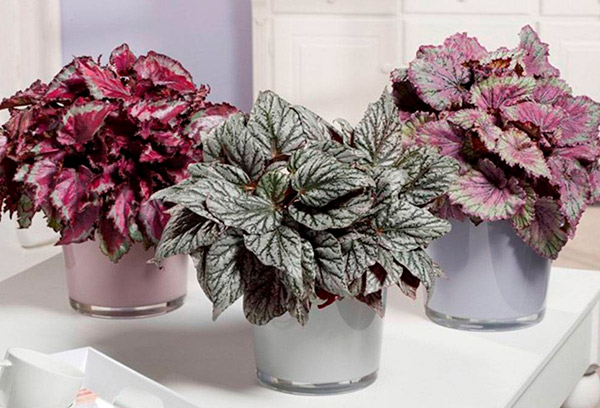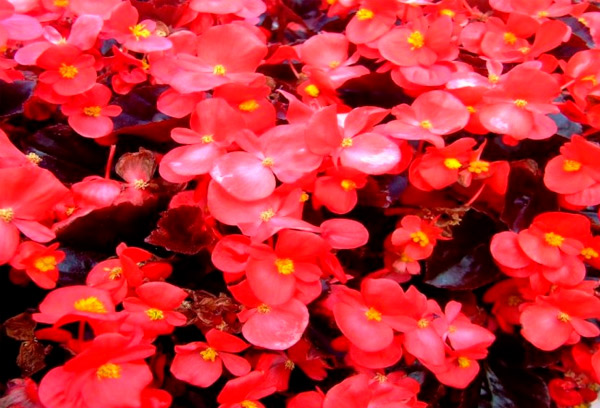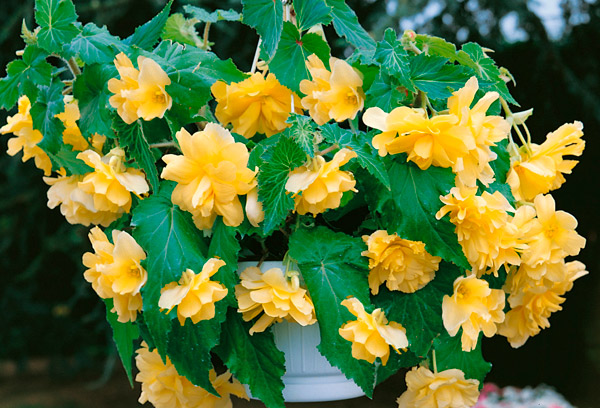New publications
Plants
Begonia
Last reviewed: 11.03.2025

Begonia is a genus of perennial herbaceous plants, comprising over 1,800 species, found in tropical and subtropical regions. These decorative plants are valued for their beauty, unique leaves, and vibrant flowers. The species of Begonias can range from shrubs to compact plants, making them versatile for use both indoors and outdoors. Some species are cultivated for their ornamental leaves, while others are appreciated for their bright and eye-catching flowers, which can be white, pink, red, orange, or yellow.
Begonias are among the most popular plants for indoor decoration and are often used in garden design. They can be planted in pots, containers, or garden beds, creating bright accents in both interior and outdoor spaces. Furthermore, Begonias are well-suited to grow in conditions with limited light, making them an excellent choice for areas with insufficient sunlight.
Etymology of the name
The genus name Bauhinia was given in honor of michel bégon, a french botanist and governor of the island of haiti in the 17th century. Bégon was known for his work in botany, and the name was chosen to honor his contributions when the genus was studied and classified in europe.
The etymology of the name also highlights bégon's historical significance in botany and his contribution to the exploration and dissemination of knowledge about tropical flora. This name became a symbol of discoveries in exotic plant species, especially regarding ornamental plants.
Life form
Begonias exhibit a wide variety of life forms. Some species are low-growing shrubs, while others can be trailing plants or groundcovers. Many species have succulent stems, which allow them to retain moisture and thrive in tropical conditions with periods of drought. These plants often form dense thickets in the wild, which helps them compete for space and resources with other plants.
Depending on environmental conditions, Begonias can vary in size, shape, and color. Indoors, they typically grow as compact shrubs with vibrant leaves and flowers, serving not only as decorative elements but also as a source of positive emotions and enhancing the atmosphere in the room.
Family
Begonias belong to the family Begoniaceae, which includes around 1,500 species and is widely distributed in tropical regions of the world. This family primarily consists of plants that can be either herbaceous or shrubby, and they are characterized by their ornamental leaves and unisexual flowers. Many species of Begonias have distinctive ovate or heart-shaped leaves, often with vibrant or unusual colors and patterns.
Plants in the Begoniaceae family are widely used in ornamental gardening and also have economic value in agriculture, as some species are used to produce natural dyes. Begonias are appreciated for their adaptability, ability to thrive in different conditions, and their capacity to root and propagate easily.
Botanical characteristics
Begonias have distinctive botanical features that make them easily recognizable. The leaves of these plants can vary in shape: from simple oval forms to more complex shapes with serrated edges or characteristic spots. The leaves often have a glossy surface, and their color can range from green to deep burgundy, with bright speckles or patterns. The flowers of Begonias are also decorative, with some species having solitary flowers, while others form clusters.
The fruits of Begonias are capsules that open when mature, dispersing small seeds. These plants also have a strong root system that helps them quickly adapt to various conditions and provide stability to the plant.
Chemical composition
Begonias contain a variety of bioactive substances that may have beneficial effects on human health. Flavonoids, organic acids, tannins, and saponins have been found in their leaves and stems, which possess antioxidant and anti-inflammatory properties. While these plants are not considered primary sources of medicinal compounds, they are sometimes used in folk medicine for treating colds and skin inflammations.
Some species of Begonias contain essential oils, which are used in aromatherapy and cosmetics. These plants are also known for their air-purifying properties, absorbing carbon dioxide and releasing oxygen, which can improve the air quality in indoor spaces.
Origin
Begonias are native to tropical and subtropical regions of south america, africa, and asia. These plants naturally grow in forests and along coastal areas, where the climate is characterized by high humidity and moderate temperatures. Begonias have adapted to a variety of climatic conditions and can grow in both tropical forests and more open areas such as highlands.
The species diversity of Begonias helps them thrive in a wide range of conditions — from humid tropics to drier and cooler regions. As these plants were spread beyond their natural ranges, they became popular as ornamental plants.
Ease of cultivation
Begonias are easy to grow in tropical and subtropical climates, as their temperature and humidity requirements are naturally met. They are not demanding in terms of soil and can grow in various soil types, preferably loose and well-drained. Indoors, they require a well-lit location but do not tolerate direct sunlight, which can cause leaf burns.
Begonias are low-maintenance but need regular watering, humidity, and a sufficiently warm temperature for active growth. These plants can be easily propagated from seeds or cuttings, making them ideal for ornamental gardening and indoor decoration.
Species, varieties
The Begonia genus includes over 1,800 species, which can be divided into several main groups depending on their growth form, flower characteristics, and other traits. The species of Begonias range from low-growing ground covers to large shrubs. Each group has its unique features and is used in different areas of gardening and landscape design.
Species of Begonias:
- Tuberous Begonia (Begonia tuberosa) – this is one of the most popular species, widely used in horticulture due to its large and colorful flowers. Tuberous Begonias have big flowers that can be red, pink, orange, or white. The plant grows to a height of 30-40 cm and is perfect for growing in containers and pots.

- Royal Begonia (Begonia rex) – known for its large ornamental leaves, which can be red, green, or silver with various patterns. These Begonias are valued for their decorative qualities, rather than their flowers, which are usually inconspicuous. Royal Begonias are often used as houseplants and prefer partial shade.

- Ever-blooming Begonia (Begonia semperflorens) – a small plant with compact growth, which produces small flowers in white, pink, and red shades. This species is ideal for landscaping and can also be used in hanging pots and baskets. It is resistant to direct sunlight and is highly valued in horticulture.

- Trailing Begonia (Begonia pendula) – these are trailing varieties with long, hanging stems adorned with numerous bright flowers. Trailing Begonias are used for hanging baskets and pots, and their decorative qualities make them perfect for terraces and balconies.

Varieties of Begonias:
- Carmen – a variety with large, bright red flowers, ideal for planting in the ground or containers. This variety is especially attractive in floral compositions.
- Dragon wing – this variety has dark green leaves and bright red or pink flowers. It is perfect for use as a decorative plant in gardens or rooms with sufficient light.
- Nonstop – known for its continuous blooming throughout the season. This variety comes in various flower shades, from bright reds to soft pastels, and is particularly popular in horticulture.
- Whopper – a large variety with big, attractive flowers, used as a garden plant. It is highly resistant to diseases and adverse weather conditions.
Each of these varieties has its specific care requirements, allowing gardeners to choose the most suitable species for their conditions.
Size
The size of a Begonia depends on the species and growing conditions. Some species can grow up to 30-40 cm tall, while others, such as Begonia rex, can reach up to 1 meter. Indoors, plants typically remain compact, growing to a height of about 40 cm.
Size also depends on care methods and growing environment. In greenhouses or outdoor gardens, Begonias can grow much taller, forming lush shrubs with vibrant flowers and leaves.
Growth rate
Begonias are fast-growing plants, especially under favorable conditions such as moderate temperatures and regular watering. In tropical climates, Begonias can quickly reach their maximum height within a few months.
In indoor conditions with limited space, the growth rate may be slightly slower, but with proper care and adequate lighting, they can develop actively and maintain their decorative appearance throughout the year.
Lifespan
Begonias are perennial plants that, with proper care, can live for several years. Indoors, their lifespan typically ranges from 2 to 5 years, depending on the species and care conditions.
The plant can continue to grow and bloom throughout its life cycle, but regular repotting and soil renewal help prolong its decorative qualities and vitality.
Temperature
Begonias prefer warm conditions for growth, with an optimal temperature range of 18°c to 25°c. They are sensitive to cold and do not tolerate frost. During the winter, it is important to avoid sharp temperature fluctuations, as they can slow down growth and even damage the plant.
In indoor conditions, the temperature should also remain within this range to avoid stress on the plant. When growing Begonias in greenhouses or outdoors, it is essential to protect them from cold and provide a warm spot during the winter months.
Humidity
Begonias prefer moderate to high humidity, especially during the hot months. The optimal humidity level for these plants is between 50–70%. Lack of humidity can cause wilting and leaf drop, as well as a decrease in ornamental qualities.
To maintain optimal humidity, you can regularly mist the plants or use humidifiers, especially during the winter when indoor air becomes dry due to heating.
Lighting and placement in the room
Begonias prefer bright but diffused light. It is best to place them on windows facing east or west, where they will receive enough light without direct sunlight. Direct sunlight can cause leaf burns, so it is important to avoid placing the plants on south-facing windows or in areas where the sun's rays fall on the leaves for extended periods. If natural light is insufficient, supplemental lighting, such as grow lights, can be used, especially during the winter months when the daylight hours are short.
When placing Begonias indoors, it is important to keep in mind that they do not tolerate cold drafts or sudden temperature fluctuations. Therefore, avoid placing the plant near air conditioners, windows with open casements, or sources of heat, such as radiators and heaters. These factors can cause stress to the plant, slowing down its growth and deteriorating its ornamental qualities.
Soil and substrate
For Begonias, it is essential to choose a loose, well-drained, and nutrient-rich substrate. The optimal soil mix consists of garden soil, peat, sand, and perlite in a 2:1:1:1 ratio. This combination ensures that the plant receives adequate air and moisture permeability for the roots, allowing the plant to develop without risk of rotting. Perlite and sand improve the soil structure, preventing compaction and promoting quick water drainage, which is critical for the health of Begonias.
The soil's ph for Begonias should be slightly acidic, ranging from 5.5 to 6.5, to facilitate optimal nutrient absorption. Good drainage is also crucial to ensure that excess moisture doesn't accumulate around the roots, as this could lead to root rot. For this, it is recommended to add a layer of expanded clay or fine gravel at the bottom of the pot.
Watering (summer and winter)
In the summer months, Begonias require careful and regular watering. During warm months, the plants grow actively and need more water, but it is essential to avoid water stagnation in the pot. The soil should remain moderately moist but not waterlogged, as this can cause root rot. Watering should be done when the top layer of soil begins to dry, but not completely.
In winter, watering should be reduced, as Begonias enter a dormant phase. During this time, the plant requires much less water, and watering should only occur when the top layer of soil is completely dry. It is important not to overwater the soil in winter, as excess moisture can lead to fungal diseases and root rot.
Fertilizing and feeding
To stimulate growth and flowering, Begonias require regular feeding. During the growing season, from spring to autumn, it is recommended to use balanced liquid fertilizers rich in phosphorus and potassium to maintain the health and beauty of the plant. These components promote vibrant blooming and strengthen the root system. Fertilizing should be done every 2–3 weeks, diluted in watering water.
During winter, when Begonias are dormant, fertilizing is unnecessary. Excess fertilizer can lead to salt buildup in the soil and disrupt the plant’s metabolism, weakening it. Fertilizing resumes at the start of the new growing season.
Flowering
Begonias are known for their vibrant and decorative flowers, which can range from white to rich red and orange. The flowers can be either solitary or clustered, making them particularly attractive for ornamental purposes. Begonias bloom for several months, typically from spring to autumn, adding bright accents to interiors and garden compositions.
Flowering depends on the species and growing conditions. For example, tuberous Begonias are known for their large, vibrant flowers, while semperflorens Begonias produce smaller but numerous flowers. Regular fertilizing and proper care help ensure long-lasting and abundant blooming.
Propagation
Begonias can be propagated from seeds or cuttings. Seeds should be sown in light, moist soil at a temperature of 22–25°c. The seeds typically germinate within 2–3 weeks. For rooting cuttings, it is best to use stem or leaf cuttings, which are planted in a mixture of sand and perlite. The cuttings usually root within 2–3 weeks.
Seed propagation is more commonly used to obtain new plants from known cultivars, while cutting propagation is faster and more common for home use, especially for preserving the parent plant's traits.
Seasonal features
Begonias require special care depending on the season. In the summer, they grow actively and need regular watering, feeding, and protection from pests. It is important to provide the plants with adequate light and stable temperature for normal development.
In winter, Begonias enter a resting phase when growth slows down, and the need for water and nutrients significantly decreases. During this time, it is essential to reduce watering and avoid fertilizing to give the plants time to recover and prepare for the new growth cycle.
Care features
Caring for Begonias requires attention to several key aspects: lighting, humidity, temperature, and watering regularity. These plants do not tolerate direct sunlight, so they need soft, diffused light. It is important to maintain optimal humidity levels and avoid letting the soil dry out.
Begonias are sensitive to temperature fluctuations and drafts, which can slow their growth. Therefore, they should be placed away from sources of cold air and in areas with temperatures ranging from 20°c to 25°c.
Care in indoor conditions
For successful indoor cultivation of Begonias, it is important to provide them with proper conditions, such as adequate lighting and humidity levels. The most suitable places for Begonias are windows with an eastern or western exposure, where they receive enough diffused light.
Additionally, it is necessary to regularly check the humidity in the room, especially in winter when the air in homes becomes dry due to heating. To maintain the required humidity level, you can use air humidifiers or regularly mist the plant's leaves. It is also important to monitor the room's temperature, avoiding sharp fluctuations and cold drafts.
Repotting
Begonias should be repotted when their roots begin to fill the pot, usually every 1–2 years. When choosing a new pot, it is essential to consider its size — it should be 3–5 cm wider than the previous one. For Begonias, it is best to choose pots made of materials that allow air and moisture to pass through, such as plastic or clay with good drainage holes.
The best time to repot Begonias is in spring when the plant starts to actively grow. When repotting, carefully remove the plant from the old pot, trying not to damage the roots, and transplant it into a new one with fresh, well-draining soil.
Pruning and crown formation
Pruning Begonias does not require regular intervention, but it can help maintain the plant's shape and health. Removing old or damaged leaves improves the plant's appearance and promotes healthy growth. To maintain a compact shape and stimulate new shoot growth, it is recommended to periodically shorten the stems, especially in trailing varieties.
If the Begonia grows too much or becomes sparse, pruning helps shape the plant and improve its decorative appearance. Regular pruning also increases the number of flowers and promotes fuller, bushy growth.
Potential problems and solutions
One of the main issues with growing Begonias is root rot, which occurs due to overwatering or inadequate drainage. To prevent this, it is important to monitor the soil's moisture level and ensure proper drainage. If root rot occurs, the affected roots should be carefully trimmed, and the plant should be repotted into fresh soil.
Begonias can also suffer from nutrient deficiencies, which manifest as slow growth and poor flowering. To correct this, it is important to regularly fertilize the plant during the active growth period using a balanced fertilizer with a high potassium and phosphorus content.
Pests
Common pests that affect Begonias include spider mites, aphids, and whiteflies. To prevent their appearance, it is important to regularly inspect the plant for pests and treat it with appropriate insecticides or natural solutions like soapy water.
To protect against pests, avoid overwatering and ensure good air circulation around the plant. Weak plants are more susceptible to pest attacks, so maintaining healthy Begonias through proper care is the best prevention.
Air purification
Begonias can improve indoor air quality by absorbing carbon dioxide and releasing oxygen. This helps maintain fresh air in the home, especially in poorly ventilated spaces.
Additionally, Begonias help humidify the air, which is particularly important during the winter months when heating systems tend to dry out the indoor air. This added moisture benefits both the plant and the environment.
Safety
Begonias are not toxic to humans or pets, making them safe for indoor cultivation. However, caution should be taken when handling the plant, as the sap of Begonias can cause skin irritation in some people.
Despite their non-toxicity, the vibrant flowers of Begonias may attract children or pets. It is important to monitor young children and animals to prevent them from chewing on plant parts, as this could cause mild digestive discomfort.
Wintering
Winter care for Begonias requires providing them with a cool environment with moderate humidity and stable temperatures between 15°c and 18°c. Watering should be reduced during the dormant period, and it is essential to avoid exposure to cold drafts or temperature fluctuations.
Before spring, it is recommended to gradually increase the light levels and watering to encourage growth and flowering in the new season.
Useful properties
Begonias can have useful properties in traditional herbal medicine, particularly due to their antioxidant and anti-inflammatory components found in their leaves. Some species are used to treat mild skin conditions and inflammation.
In addition to their medicinal properties, Begonias are also popular in cosmetics for their moisturizing and restorative qualities, helping to improve skin condition.
Use in traditional medicine or folk recipes
In some parts of the world, Begonias are used in folk medicine to treat skin diseases such as eczema and dermatitis, as well as to alleviate colds. Begonia leaves are often used to make infusions and ointments with antiseptic properties.
However, it is important to note that scientific research in this area is limited, and the use of Begonias for medicinal purposes should be consulted with a healthcare professional.
Use in landscape design
Begonias are widely used in landscape design for their decorative value. They are ideal for creating bright flower compositions, borders, and accent areas in gardens and parks. Begonias also suit vertical gardens and hanging compositions thanks to their trailing varieties.
Due to the variety of species and cultivars, Begonias can be used in various landscape projects, providing long-term decoration in both summer and winter.
Compatibility with other plants
Begonias combine well with other decorative plants, especially those with similar moisture and lighting needs. Begonias can be planted in groups with other flowering plants to create bright and contrasting compositions.
However, it is essential to avoid planting them next to plants that require different moisture levels or sunlight, to prevent competition for resources and ensure harmonious development of all plants.
Conclusion
Begonias are versatile and undemanding plants that can become a decoration for any interior or garden. Their bright flowers and decorative leaves make them a popular choice for gardeners and florists. With proper care, Begonias can delight their owners with beautiful flowers and decorative appearance for many years.
Whether indoors, on balconies, or in gardens, Begonias can bring beauty and ambiance to any space, providing comfort and harmony in the home.
